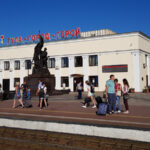Nakhabino-Podolsk is the MCD-2 route, about 80 km long. The launch of the diameter took place on November 21, 2019, simultaneously with MCD-1. The grand opening took place
WDC 1 scheme
Nakhabino-Podolsk is the MCD-2 route, about 80 km long. The launch of the diameter took place on November 21, 2019, simultaneously with the MCD-1. The grand opening took place at the Belorussky railway station. The movement was opened by the President of the Russian Federation Putin V.V. and Mayor of Moscow S.S. Sobyanin.
According to the schedule, the interval of movement of trains of Moscow central diameters will be on average 12 minutes, depending on peak hours. In the future, the intervals between trains will be adjusted. Trains on the route will run from 5:30 to 1:00. On the diagram it is designated as D2. Fuchsia color.

The Ivolga class of trains will operate on the line. In total, it is assumed that 24 trains will carry passengers of Podolsk-Nakhabino diameter.
Travel time from Podolsk to Nakhabino will be about 2 hours. There are 36 stops on the route in total.
It is assumed that the line will unload the subway. Muscovites and residents of the Moscow region will be able to adjust their trips from the moment the MCD-2 route opens. Many stations will have convenient transfers to the MCC and metro.
Important! From MCD-2, it will be possible to make a free transfer to the metro and MCC, subject to the validation of the travel card at the exit.
More about tariffs
MCD-2 trains will pass and stop at 4 railway stations in Moscow: Leningradsky, Kazansky, Kursky, Yaroslavsky.
The fare within Moscow can be paid using the Troika card. 1 trip – 38 rubles at the wallet tariff.

Benefits of launching the MCD-2 route:
- Residents of Podolsk and Nakhabino will be able to quickly get to Moscow;
- The line will connect the opposite Moscow districts of the North-West and South-East Administrative Districts, which will also speed up travel;
- Quick transplant. Route stops are located close to metro and MCC stations;
- The absence of a technological break, like electric trains;
- Without transfers you can get to the railway stations: Kursky, Yaroslavsky, Kazansky, Leningradsky;
- Fare will be zonal;
- free transfer to metro and MCC.
Schedule
MCD-2: scheme of stations on the map
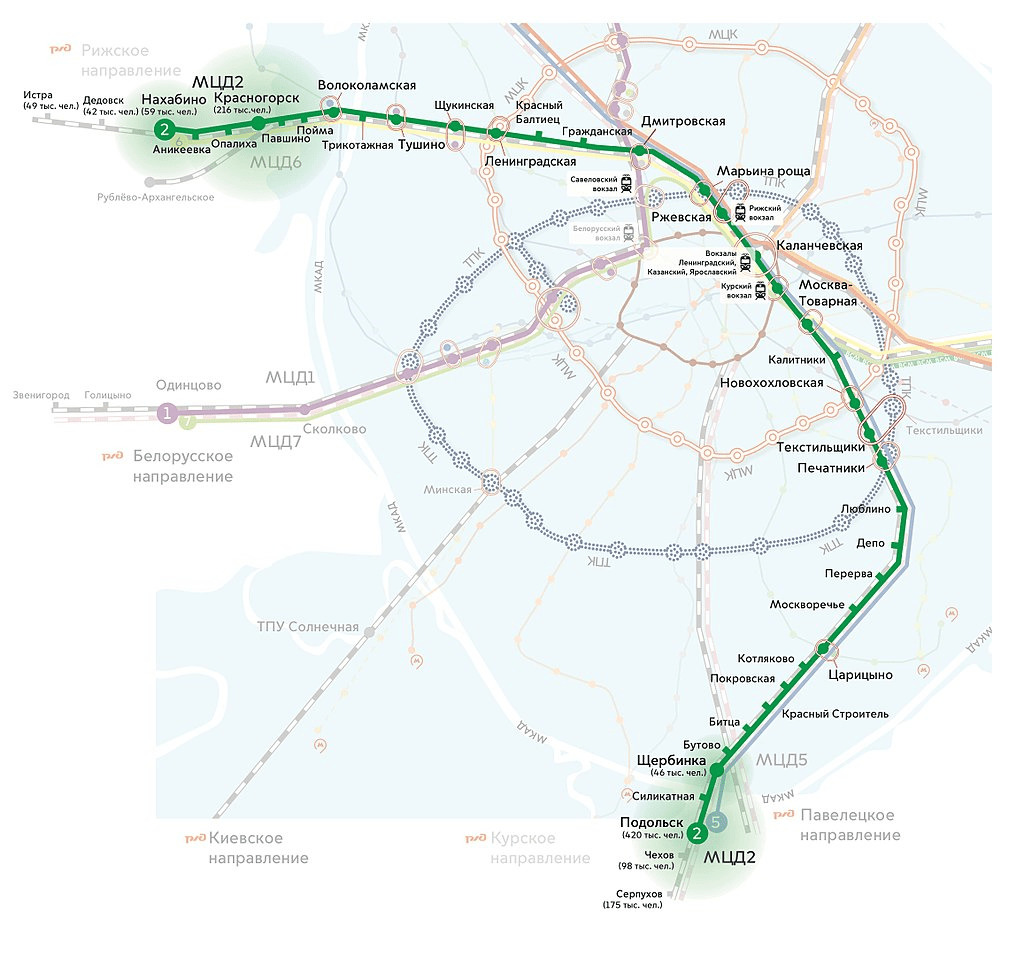
MCD-2 stops
In parentheses are the metro and MCC stations, to which you can make a quick transfer.
- Nakhabino
- Anikeevka
- Opaliha
- Krasnogorsk
- Pavshino
- floodplain
- Volokolamskaya (Metro Volokolamskaya)
- Knitted
- Tushino (metro Tushinskaya)
- Schukinskaya
- Leningradskaya (Metro Voykovskaya)
- red baltic
- civil
- Dmitrovskaya (Metro Dmitrovskaya)
- Marina Grove
- Rzhevskaya
- Kalanchovskaya (Metro Komsomolskaya)
- Kursky railway station (metro station Kurskaya)
- Moscow-commodity
- gates
- Novokholovskaya
- Tekstilshchiki (metro Tekstilshchiki)
- Pechatniki (Metro Pechatniki)
- Lublino
- Depot
- Pererva
- Moskvorechye
- Tsaritsino (Metro Tsaritsino)
- Kotlyakovo
- Pokrovskaya
- red builder
- Bitza
- Butovo
- Shcherbinka
- silicate
- Podolsk
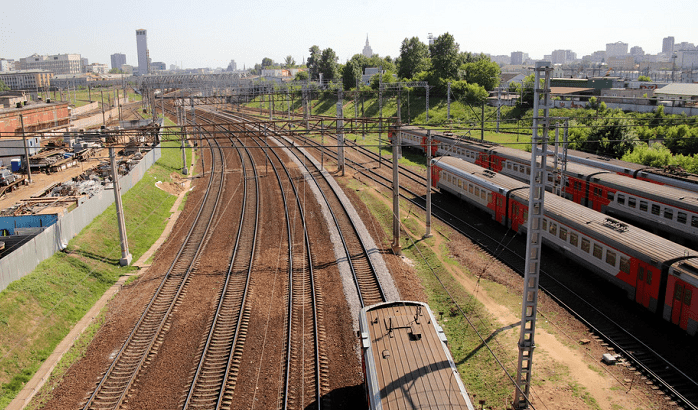
Citizens, guests and residents of the Moscow region will gladly accept the opening of the Podolsk-Nakhabino line of Moscow central diameters.
MCD is a new type of urban transport. This is a whole network of connected railway routes, which, in fact, form the lines of the surface metro.
The first diameters MCD-1 (Odintsovo-Lobnya) and MCD-2 (Nakhabino-Podolsk) were launched.
All the details about the project and photos from the opening are in our material.
The diameters connect the disparate directions of the railways with passages through the whole of Moscow, turning them into full-fledged ground metro lines, through which you can drive through the capital without transfers and get to the nearest cities of the Moscow region.
The absence of final stops at stations increases the number of routes and reduces the number of transfers and travel time for passengers.

- trains travel through all of Moscow;
- work schedule from 5:30 am to 1:00 am;
- interval between trains – 5-6 minutes during peak hours;
- no day break
- convenient platforms and comfortable trains;
- fare both in the metro and MCC;
- free transfers to the metro and MCC within 90 minutes;
- many payment methods – Troika card, Mastercard PayPass, Visa PayWave, Apple Pay, GooglePay, Samsung Pay.
Five diametrical lines have been developed:
- D1 Belarusian – Savelovsky;
- D2 Kursk – Riga;
- D3 Leningrad-Kazan;
- D4 Kiev – Gorky;
- D5 Yaroslavsko-Paveletskaya.
*Other routes may be considered in the future.
MCD-1 Belarusian – Savelovsky
The first diameter improved transport services for residents of the cities of Lobnya, Dolgoprudny and Odintsovo near Moscow. Travel time for them has been reduced by an average of 40%. The city has become closer for residents of more than 20 Moscow districts, their travel time has been halved.
Approximately 43 million passengers per year will use the MCD-1.
Launch date: November 21, 2019
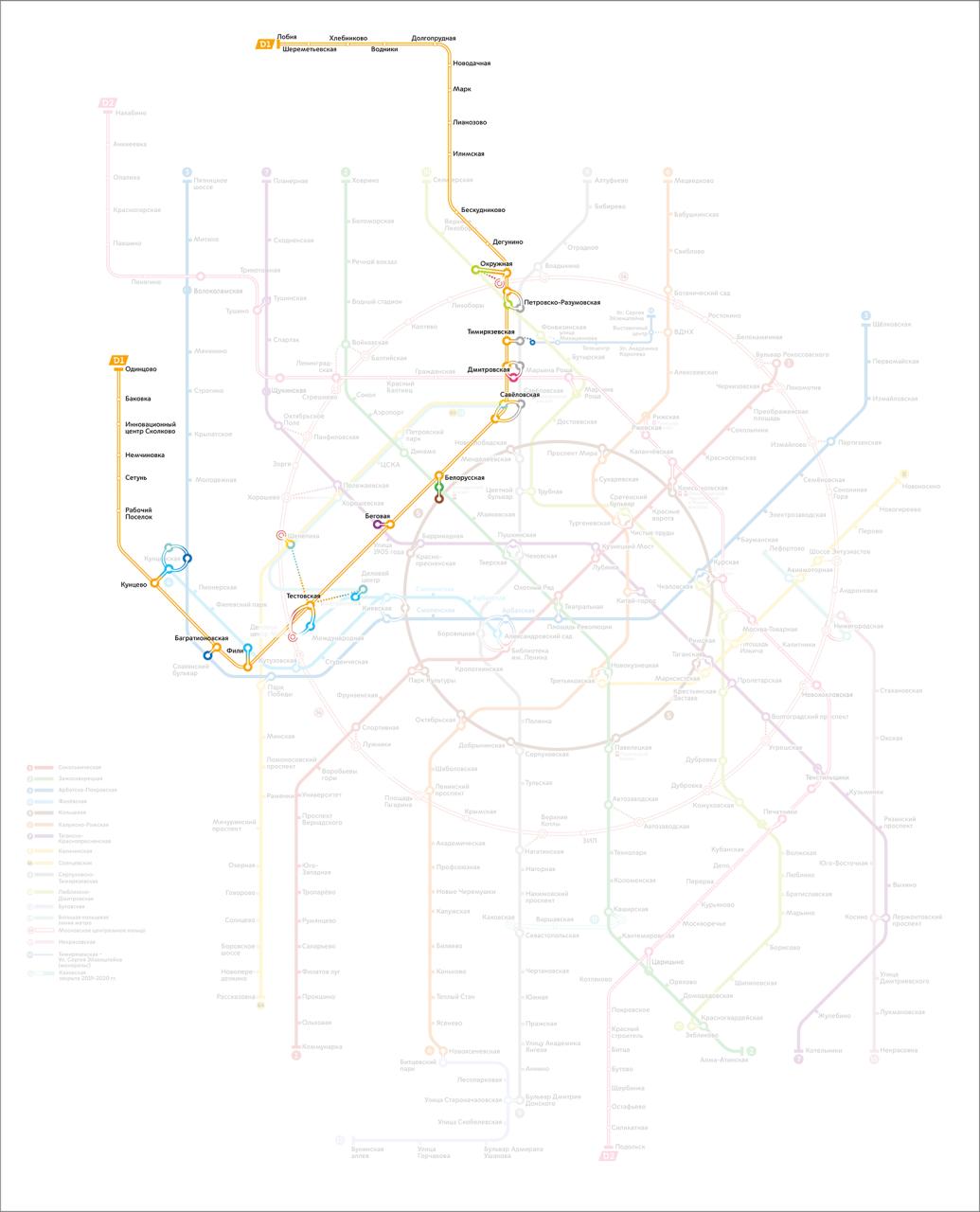
| Diameter length | 52 km |
| Travel time | 80 minutes |
| Number of stations | 28 |
12 MCD-1 stations became interchange stations for the metro and the MCC.
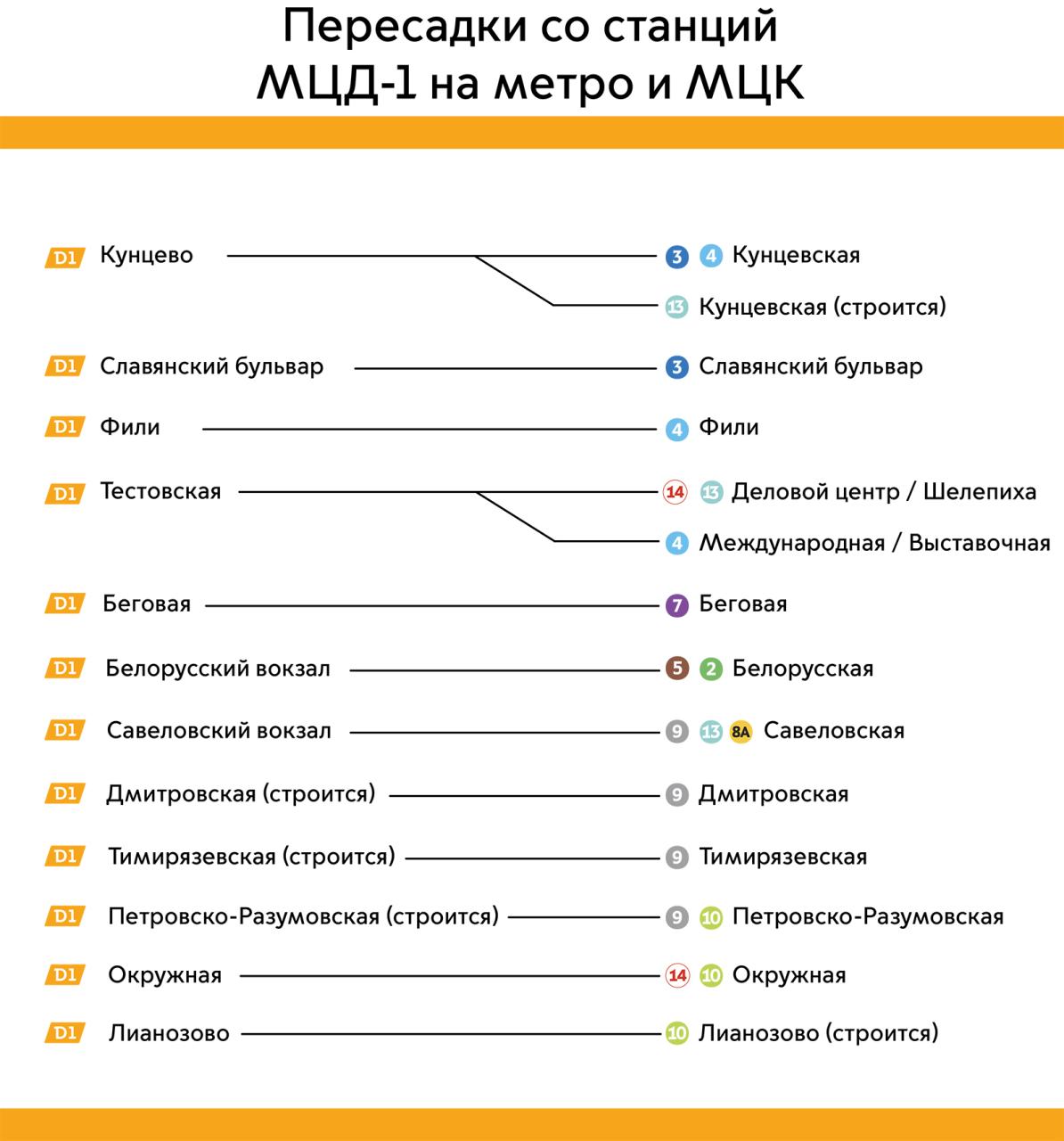
MCD-2 Kursko-Rizhsky
The second diameter improved transport services for residents of the cities of Nakhabino, Krasnogorsk, Podolsk near Moscow and reduced travel time by an average of 30%. The city has become closer for residents of 27 Moscow districts, their travel time has been halved.
More than 48.5 million passengers a year will use the MCD-2.
Launch date: November 21, 2019
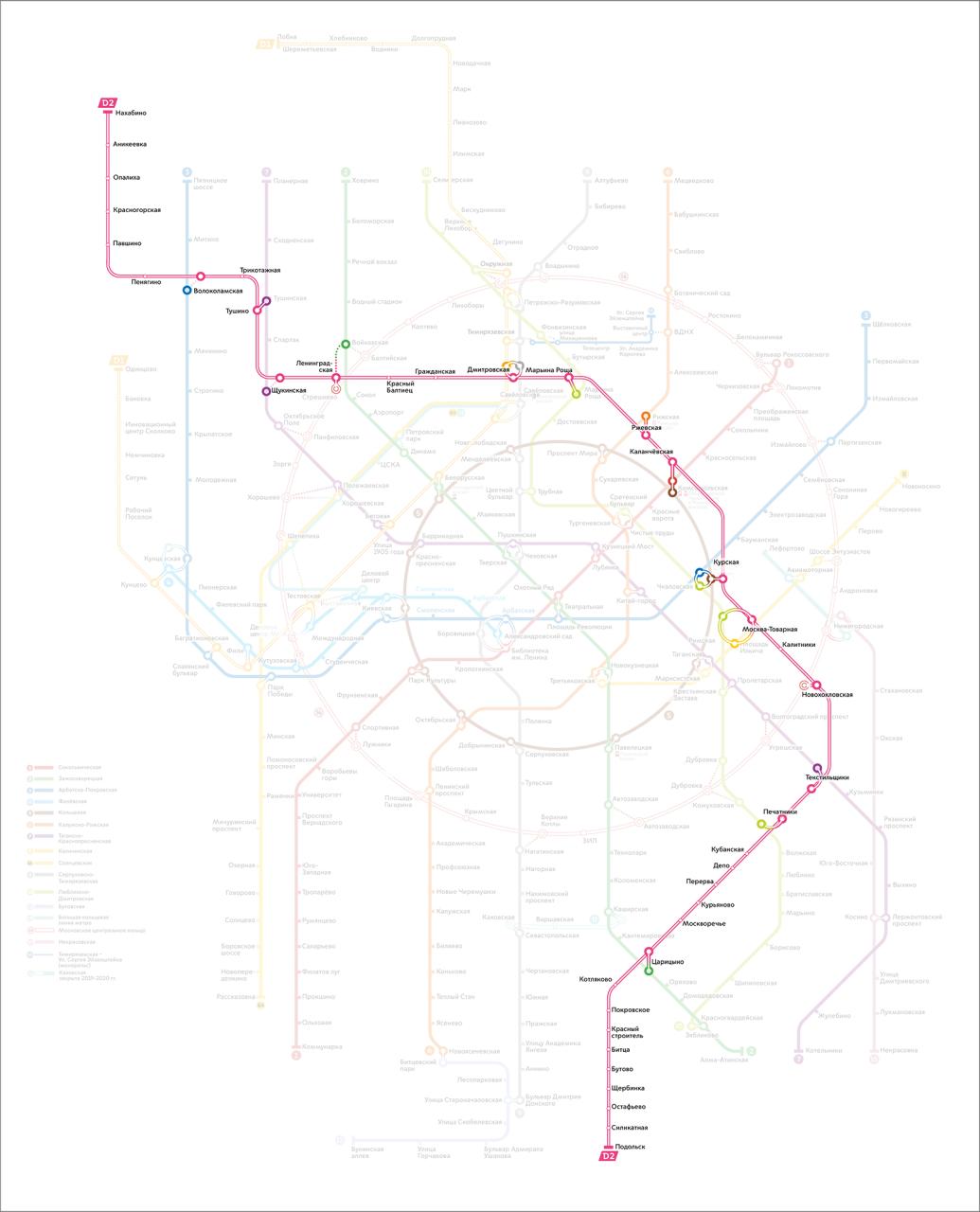
| Diameter length | 80 km |
| Travel time | 116 minutes |
| Number of stations | 38 |
15 MCD-2 stations have become interchange stations for the metro and the MCC.
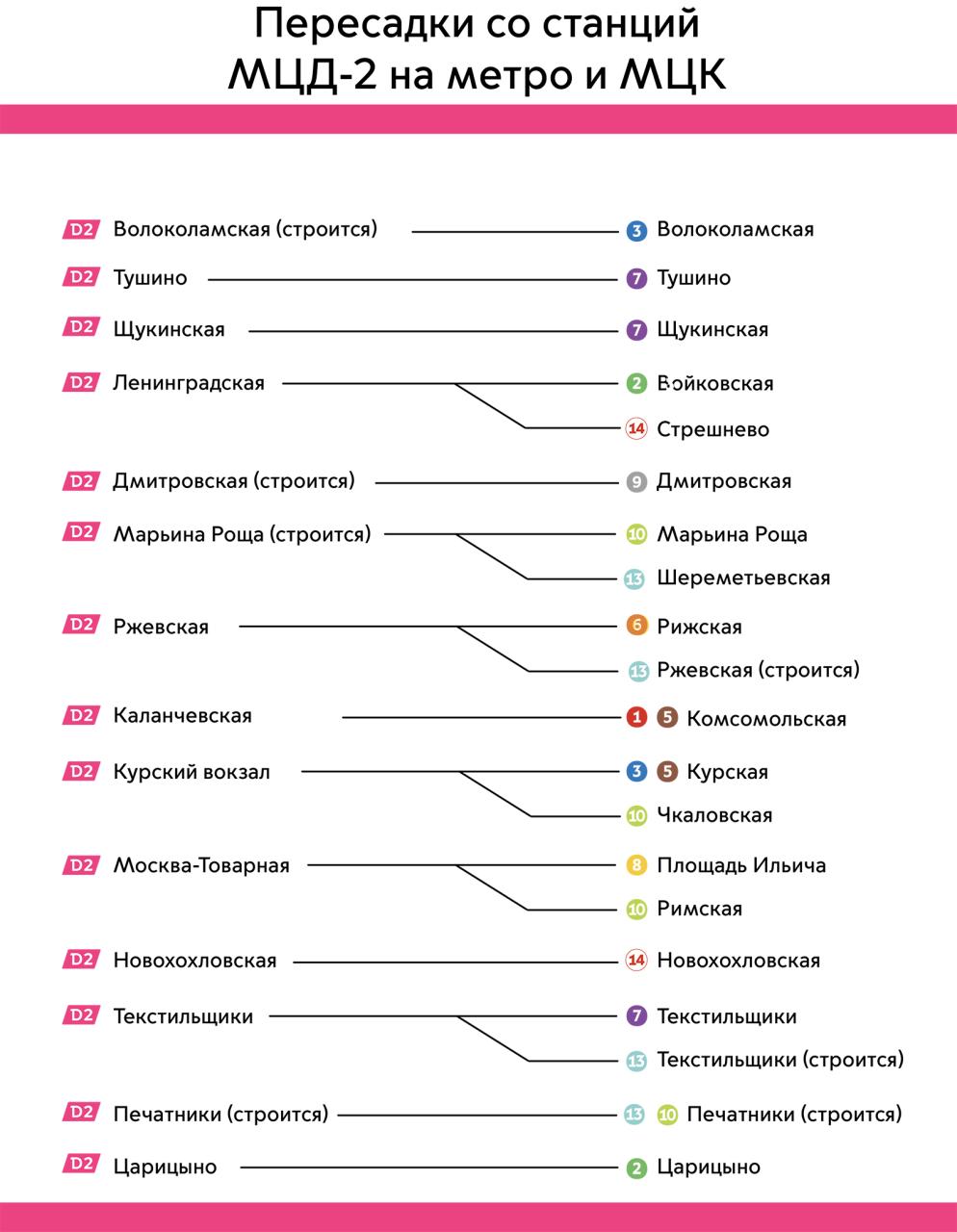
МЦД-3 Leningradsko-Kazanskiy

The route and its parameters can be changed.
| Diameter length | 88 km |
| Travel time | 100 minutes |
| Number of stations | 43 |
14 MCD-3 stations will become interchange stations for the metro and the MCC.
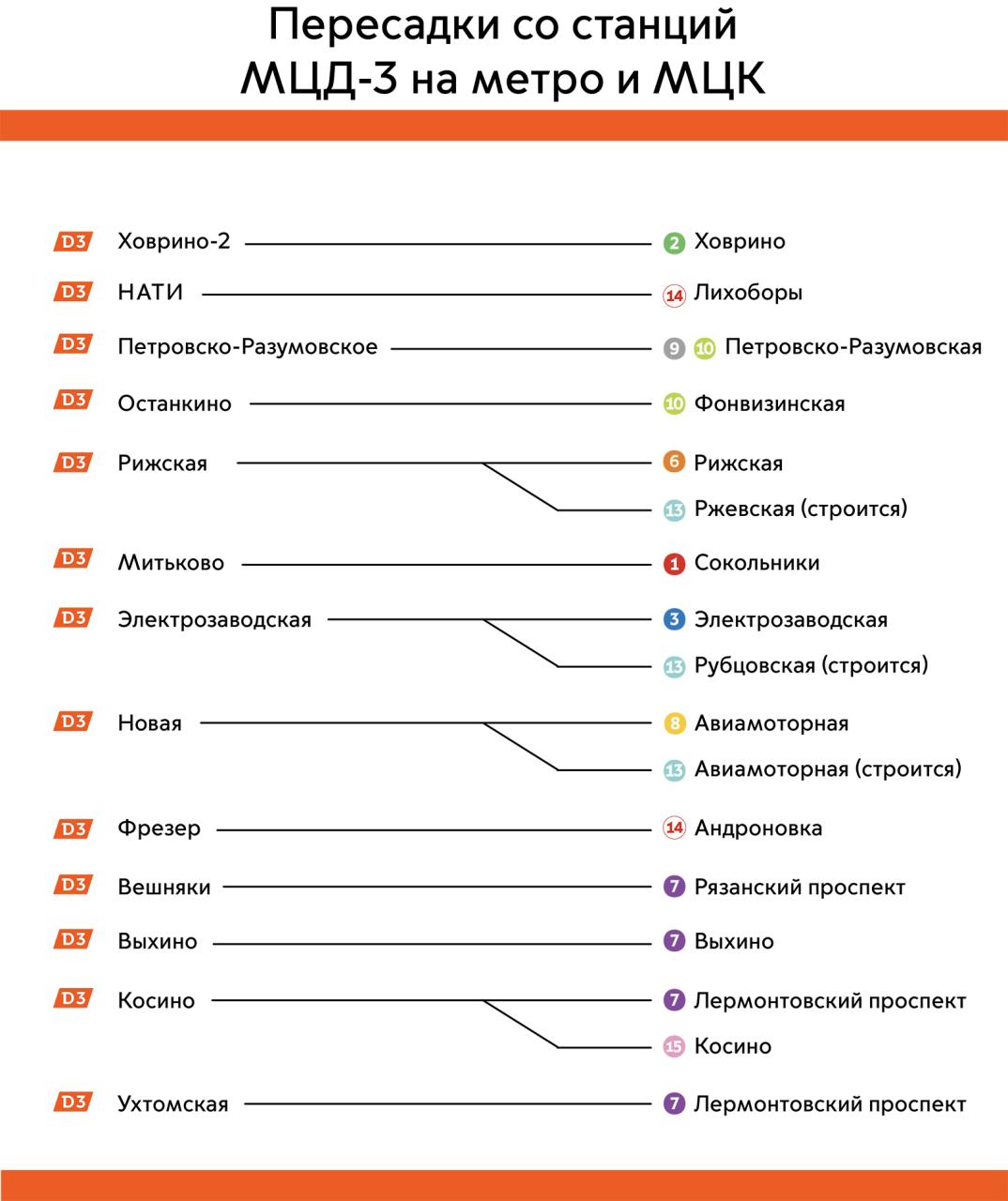
MCD-4 Kiev-Gorky
| Diameter length | 86 km |
| Travel time | 135 minutes |
| Number of stations | 38 |
19 MCD-4 stations will become interchange stations for the metro and the MCC.
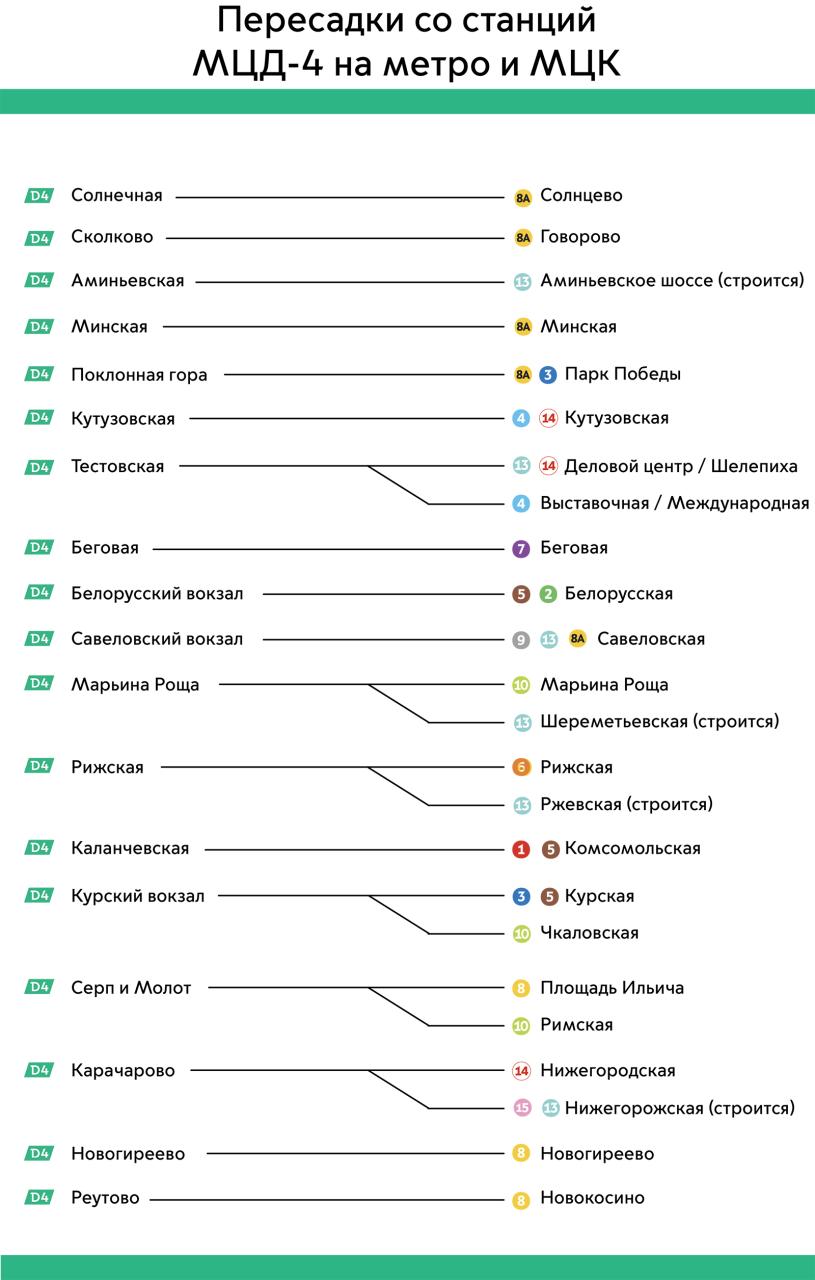
MCD-5 Yaroslavsko-Paveletsky
| Diameter length | 75 km |
| Travel time | 110 minutes |
| Number of stations | 39 |
10 MCD-5 stations will become interchange stations at the MCC.
Ivolgi trains run on the MCD
Ivolgi are new electric trains that will run along the MCD routes along with other electric trains. They are comfortable and in no way inferior to the Lastochkas plying the MCC. These are spacious cars without vestibules with wide doorways and handrails for people with limited mobility.
MCD fare
Trips to the MCD in Moscow will cost the same as in the metro, MCC and surface transport. Passengers will be able to transfer from diameters to the metro and the Moscow Central Ring free of charge.
Travel on the MCD until December 8 is free.
Three tariff zones will operate at the MCD:
- Central – for trips within Moscow (within the boundaries of the stations Mark – Setun and Volokolamskaya – Ostafyevo);
- Prigorod – for trips outside the stations Mark, Setun, Volokolamskaya, Ostafyevo and to the final stations of the MCD Odintsovo – Lobnya, Nakhabino – Podolsk.
- Dalnaya – for trips from stations outside the MCD.
Russian Railways, together with the Ministry of Transport of the Russian Federation, the Governments of Moscow and the Moscow Region, is implementing a project to create a new high-quality service for railway passengers – the Moscow Central Diameters (MCD).
The project involves the development of suburban-urban transportation on railway lines connecting urban areas and the nearest suburbs through the center of the capital. It is planned to reconstruct stopping points and stations on the territory of Moscow and the Moscow region, including taking into account the arrangement of convenient transfers to metro stations, the MCC, as well as to surface urban transport.
Comfortable Ivolga trains will be launched at the MCD.
The quality of service on the MCD lines will be focused on the set standards of the metro and MCC. The movement of MCD trains will be carried out from 5:30 am to 1:00 am without a day break.
The implementation of the I stage of the MCD project will ensure the combined movement of MCD trains in a common schedule with other suburban trains and a minimum interval of 5-6 minutes during peak hours. The interval of movement of MCD-1 trains will be 15 minutes, on the MCD-2 section – 12 minutes.
During the implementation of the project, MCD stations will be reconstructed by 2024. There will be sheds for the entire length of the platform, new paving stone flooring and modern LED lighting. The platforms will also feature benches, trash cans, information boards, vending machines and panic buttons. Passengers will be able to use free Wi-Fi and chargers for gadgets.
The launch of the MCD involves the improvement of the tariff menu and the integration of ticket systems for suburban and urban transport. As a result, passengers will be able to use the Troika card to pay for travel.
For the full-fledged operation of the MCD while maintaining the movement of long-distance suburban and passenger trains, Russian Railways is building additional main tracks on radial railway lines, developing passenger infrastructure, including the construction of new stopping points and transport hubs.
The priority projects of the WDC include several areas:
MCD projects are the key projects of the Program for the Development of the Railway Infrastructure of the Central Transport Hub, taking into account the organization of promising diametrical routes for the period 2019-2024, prepared in accordance with the Decree of the President of the Russian Federation Putin V.V. dated May 7, 2018 No. 204.
Moscow Central Diameters are railway routes that pass through the whole of Moscow and have a number of advantages:
- train traffic from early morning to late evening without long breaks;
- the possibility of paying for travel with a Troika card (as well as bank and social cards) without buying tickets at the box office and with a free transfer to the metro.
From November 21, 2019, the first two diameters work:
- MCD-1: Odintsovo – Lobnya;
- MCD-2: Podolsk – Nakhabino.
Troika payment
On the Belorussky, Savelovsky, Kursk and Riga directions, you can pay for travel with a Troika card at new rates with a free transfer to the metro.
Payment by Troika is also possible outside the MCD, but not further than Chekhov, Novoyerusalimskaya, Kubinka, Zvenigorod, Dmitrov stations, except for the direction to Usovo.
The exception is from Art. Nakhabino, Podolsk, Lobnya, Odintsovo, to some stopping points outside the MCD (the same or a neighboring ten-kilometer zone), payment by Troika is not provided (only one way, you can return). For these routes, the cost of Troika is not displayed.
It is necessary to apply the card to the turnstile or validator before each trip and always after it ends (no later than 5 hours after entering). At stations without turnstiles, you need to use validators at the exits or ticket offices.
If you do not validate the card at the exit, it may be blocked. The fee for unlocking the card is 150 rubles.
To travel further than Chekhov and the other stations mentioned above, you need to pay for the fare at the ticket office before traveling and write down the ticket on the card. In this case, a free transfer to the metro will remain. This feature may be temporarily unavailable.
Old rates
The old fares and tickets are still valid. You, as before, can buy regular tickets and subscriptions at the box office or the terminal of the Central PPC.
Regardless of the chosen method of fare payment, it will be possible to travel both in ordinary trains and in Ivolga (except for express trains). Aeroexpress trains are also available on the Odintsovo – Okruzhnaya section.
All previously issued tickets and subscriptions for a regular train remain valid – they can also be used in Ivolga and Aeroexpress trains until their expiration date.
Card activation before use
Before the first use on the MCD, the Troika card must be activated. Subscriptions can only be activated at metro ticket offices. To pay for trips on the balance, you can also activate:
- in ticket machines when replenishing the card;
- in information terminals (when remote card replenishment is activated);
- in mobile applications Moscow Metro, My Travel and others (when replenishing the card).
Social and student cards also require prior activation. Cards issued after November 21, 2019 do not need to be activated.
Booklets with information
All basic information about the new tariffs can be found in the information booklets. They are available for free at most major stations.
Central zone
Includes trips within Moscow:
- on the section Setun – Mark;
- Ostafyevo-Volokolamskaya section.
The fare on the Troika at the MCD is equal to the fare on the metro – 40 rubles. Includes a free transfer from the MCD to the metro, MCC, monorail and back within 90 minutes from the moment of the first entry.
When paying with a contactless bank card (or using other electronic wallets), the cost of the trip will be 44 rubles. You can pay with cards at special turnstiles. Payment by card is subject to availability and may not be available.
Subject to the conditions of free transfers, the following can be considered one trip:
- metro + MCD;
- MCD + metro + MCD;
- MCD + metro + MCC + metro, etc.
More details in Appendix 2 of the Decree of the Government of Moscow, pp. 18–21.
Thus, you only pay for the metro, and the trip to the MCD will be free if your trip:
- includes metro and MCD;
- passes within the boundaries of Moscow;
- the time of passage through all the turnstiles to the entrance does not exceed 90 minutes.
Subscriptions and benefits in the Central zone
At the MCD, within the Central Zone, almost all Unified metro subscriptions will be valid.
In addition to paying for a one-time trip, you can purchase a subscription for 60 trips for 1,970 rubles. As well as subscriptions without restrictions on the number of trips:
- for 1 day – 230 rubles;
- for 3 days – 438 rubles;
- for 30 days – 2,170 rubles;
- for 90 days – 5,430 rubles;
- for 365 days – 19,500 rubles.
Schoolchildren and students will be able to travel to the MCD within Moscow on a regular discount monthly metro ticket for 405 rubles (for 3 months – 1,215 rubles).
For privileged categories of citizens, it is possible to issue a free (non-monetary) subscription to a social card at the box office once a month.
Suburb Zone
Includes trips from the region to Moscow and back, or from region to region within the borders of the MCD. The Suburb zone is limited to the stations: Podolsk, Nakhabino, Odintsovo, Lobnya.
When paying by Troika, the fare will be 47 rubles. Transfer to the metro, MCC, monorail and back within 90 minutes will also be free.
Thus, a trip to the MCD will cost you 7 rubles if you do not use a metro pass and your trip:
- includes metro and MCD;
- passes within the boundaries of Moscow;
- the time of passage through all the turnstiles to the entrance does not exceed 90 minutes.
Subscriptions of the Suburb zone
Instead of Unified unlimited subscriptions for the metro in this zone, there are their own subscriptions Unified MCD MO. They are a little more expensive than regular metro passes, but they allow you to ride:
- on all sections of the MCD (Podolsk – Nakhabino, Odintsovo – Lobnya);
- by metro, MCC, monorail;
- any ground public transport in Moscow.
The cost of subscriptions without restrictions on the number of trips in the Suburb zone:
- for 1 day – 285 rubles;
- for 3 days – 545 rubles;
- for 30 days – 2,570 rubles;
- for 90 days – 6,940 rubles;
- for 365 days – 24,450 rubles.
There are no Single travel tickets for 60 trips in the Suburb zone.
Far zone
Trips outside the MCD from the far suburbs to Moscow and back.
The fare on the Troika consists of the fare to the MCD border and the fare in the Suburb zone. 90 minutes for a free transfer are counted from the moment you enter the MCD borders.
According to preliminary information, this time will be determined as the ticket validation time at the destination station minus the standard travel time from the MCD border.
More about tariffs and subscriptions
The cost of subscriptions from all stations is published on our website in the train schedule. To view, specify the station of departure and destination, as well as the date of travel.
You can learn more about the new tariff system on the website of the Moscow Central Diameters, as well as on the special website of the Central SPC.
You can also watch a video from the meeting of the Deputy Head of the Moscow Central Diameters Service of the Moscow Metro with passengers, which took place in September.
General by tariffs
1. Travel to the MCD using metro tickets is possible only if they are recorded on the Troika card. Paper tickets are not valid due to technical restrictions.
2. If several tickets are recorded on the card, then the ticket of the CPPK is used first of all, the “Unified” metro tickets are used secondly, then the balance of the card (“Electronic Wallet”).
Direction Podolsk — Nakhabino (D2)
Nakhabino-Podolsk-Nakhabino trains run every 12 minutes in this direction throughout the day: modern 11-car (double 5 + 6) Ivolga, EP2D trains, 3 Lastochka trains (usually 2 trains on weekends).
On weekends, trains run at intervals of up to 24 minutes, and on some days, due to the construction of tracks 3 and 4 of the Moscow Kurskaya – Kalanchevskaya section, even less frequently. Don't forget to check the schedule!
The first train departs from the initial stations at about 4 am, the last one at about midnight (in the center of Moscow, the last trains leave at about 1 am). Travel time for the full route will be about 2 hours.
Direction Odintsovo – Lobnya (D1)
Here the traffic pattern is more complex. 11-car Ivolgi and EP2D trains, double-deck and single-deck aeroexpress trains run every 30 minutes from early morning to late evening on three routes:
- Odintsovo – Lobnya;
- Odintsovo – Sheremetyevo Airport (travel at the MPD tariff is planned only on the Odintsovo -Belorussky station – district – district);
- The Belarusian station is Lobnya.
Early morning and late evening trains can start or end their route at the Sawyolovsky or Belarusian station.
On weekends, trains go a little less often.
In order not to get confused in the traffic scheme, we recommend watching the schedule on our website. As in other areas, it contains information about all planned changes due to repair work, as well as on delayed trains in case of failures in motion.
Please note that special trains of MCD are shorter than ordinary trains – take land closer to the beginning of the platform.
Outside of the MCD
Far electric trains in both diameters D1 and D2 will also continue to run from the stations and along diametrical routes – along the same ways in between the Orioles.
However, some long -distance trains instead of stations will be sent from Tsaritsyno and Streshnevo (Leningrad). In the Kursk direction, some electric trains from or to Tsaritsyno will follow 3 and 4 paths (former “cargo”) without intermediate stops before or from Podolsk.
Electric trains from / to Usovo and expresses
Conventional electric trains to Usovo and most expresses continue to run, but they are not included in the MSD system. The passage in them can only be paid in accordance with the current tariffs of the central PPC, payment with a “triple” is impossible.
In addition, the transit movement of electric trains from Kursk to the Belarusian direction and vice versa was stopped. Movement is expected a few years later, with the opening of a new diameter of April – railway.
Taking into account the distant trains (in which tariffs on the “three”, except for ambulances, raxes and other expresses), the interval between trains at any station D1 and D2 during peak hours on working days, as a rule, will not exceed 5-10 minutes. In non -pipe time – 15–20 minutes. Such a movement scheme will remain in the next few years, with the exception of the Moscow -Dmitrovskaya section, where the intervals during the active phase of work on the construction of 3 and 4 paths can be increased, approximately up to 18 minutes.
In the future, it is planned to build additional paths and separate the trains of the MPD from long -range trains. Then distant trains will go in accelerated mode, with stops only at key stations. It is also planned to open new diameters.
Moscow, August 6. /TASS/. The passenger movement in the third and fourth Moscow central diameters (MCD-3 and MCD-4) in the metropolitan region will be launched until 2024. This was announced on Tuesday by the deputy mayor of the capital Marat Khusnullin to reporters.
“Until the end of 2024, the first four diameters will accurately go with passengers. The fifth diameter – it is associated with the Pavelet direction – we are now urbanly working out, through which corridor it can pass, with which direction of the railway to connect it, how technologically it will work.We will finish this analytical work by mid-2020,” he said.
Earlier it was reported that the first two routes of the MCD will be launched in November. At the time of launch, the interval of train traffic will be five to six minutes during rush hour. At the first stage, this will be a movement combined with suburban electric trains, since parts of their routes will duplicate the routes of the MCD. It is assumed that in 2025 all lines connected to the MCD will be at least four-track, which will allow separating electric trains and trains of central diameters.
Diameters will become a new mode of transport that will combine the format of commuter trains and the subway, creating in fact a surface metro system.
The Moscow Central Diameters project involves the launch of five lines: the first two diameters are MCD-1 Odintsovo-Lobnya and MCD-2 Nakhabino-Podolsk. Then it is planned to launch MCD-3 from Zelenograd to Ramenskoye, MCD-4 from Aprelevka to Zheleznodorozhny and MCD-5 from Pushkino to Domodedovo. According to experts, the implementation of the WDC project will relieve the entire transport infrastructure of the capital by 10-12%.


